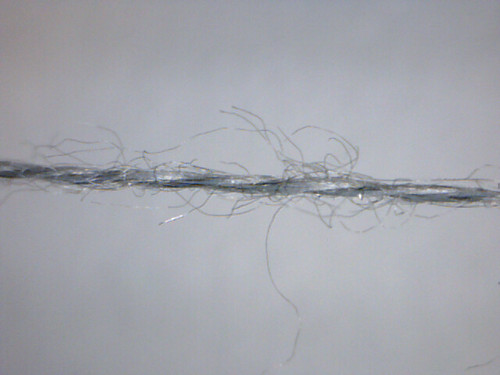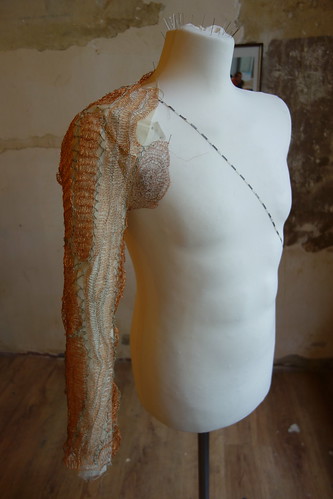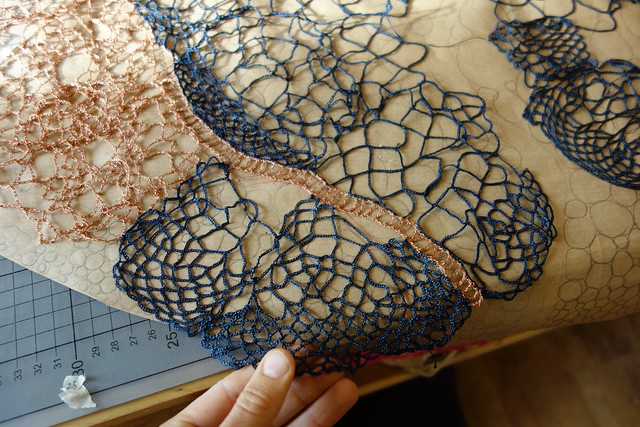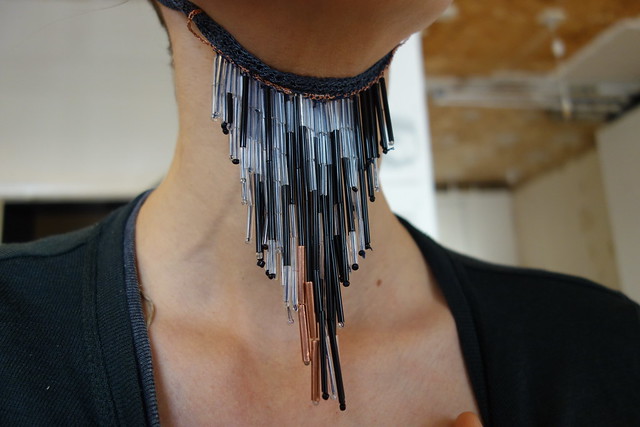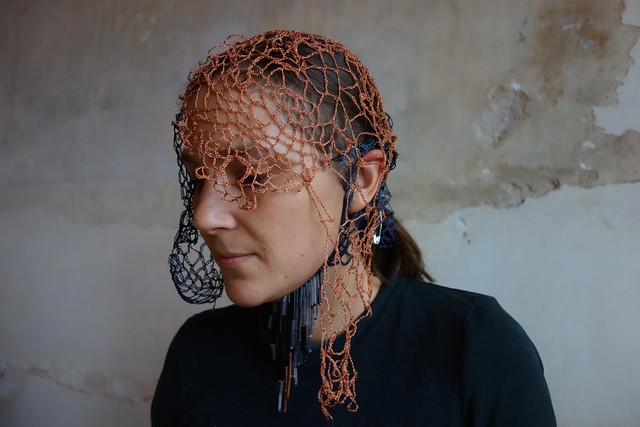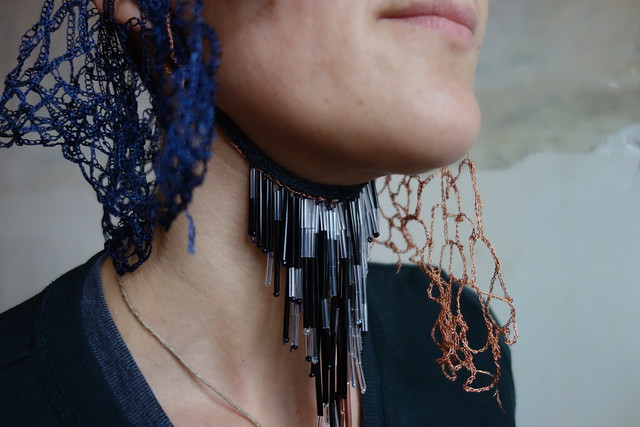Crochet Resistance
Dominique has commissioned us to crochet a resistive cladding for the performance she is currently developing. Dominique came to a talk in which I explained the ohmHook – a tool for measuring while manipulating resistance – and was fascinated by the idea that the crochet costume she had in mind could also have an electrical resistance.

Dominique’s interview with Mariam “Tales of Fabrication”:


More photo at >> https://www.flickr.com/photos/plusea/albums/72157695263141991
https://www.flickr.com/photos/14412219@N04/albums/72157697808408905
Dominique’s Crochet Resistance Armour will be worn as part of her performance lecture on Free Time. Dominique’s liquidity practice is an exercise in letting her body relax and flow with the energies of the space she is in (?), the movements that result from this balancing act are smooth but sometimes quick. To capture these movements we are crafting a fully e-textile suit of resistive armor for Dominique to wear.
This full-body armour is taking us time to make, not only because crochet is a handcraft technique, but also because as we work on it we have time to think about what it is becoming and how to solve technical details in the crochet and armour aesthetic we are aiming for. This is true for all the commissions we take that what takes time is not only the production, but the translation of ideas into patterns. What is unusual about Dominique’s commission is how detailed we are trying to go with the instantiation of theoretical ideas into physical form. This started right from the beginning with Dominique making the connection between the resistance in her own body that she performs in her Collapse series, and the electrical resistance of conductive yarns that become more conductive under strain/stress because their fibers are condensed and allow for more electrons to flow through them at a time. Continuing this translation of concepts into materials via analogies we chose to construct movement sensors by dangling coins (representing financial liquidity) in pouches strung with resistive yarn from her arms to capture the movements that result from her liquid balancing act. Other crochet sensors we are working to implement include pressure sensitive slippers that divide the voltage between two pressure points of the foot – equal pressure results in a mid-point signal and increased pressure on either sensor results in a higher or lower signal. Crochet stretch sensors across her back will possible be able to capture the tension in the body from holding the arms in their balancing position.
At the moment we are thinking to construct the armour from seperate pieces that can all link together on the body. These include:
Headpiece (liquidity sensors)
Bolero/cardigan (liquidity sensors, tension sensors)
Dress (tensions sensors, liquidity sensors)
Slippers/Stockings (balance sensor)
+ Skin resistance sensors?
Resistive Yarn
The “resistive yarn” we use to construct our textile strain sensors (movement, stretch/tension, pressure/balance) is crochet from a yarn (Nm50/2, Mm10/3) spun from 60% polyester, 40& stainless (or 80%, 20%) steel fibers. Because the spinning of the yarn adds a twist to the fibers, when this yarn is stretched (but also works for squeezing/pressure) these fibers are compressed, making better physical electrical connections between the individual steel fibers.
>> http://www.kobakant.at/DIY/?p=1978
Dominique’s Sketches
Crochet Resistance Loop
Sketch responding to Dominique’s drawings and ideas…

Reference Images
crochet membrane seriese by Sonja Bäumel


antique crochet gloves


Igne Oyasi (technique)

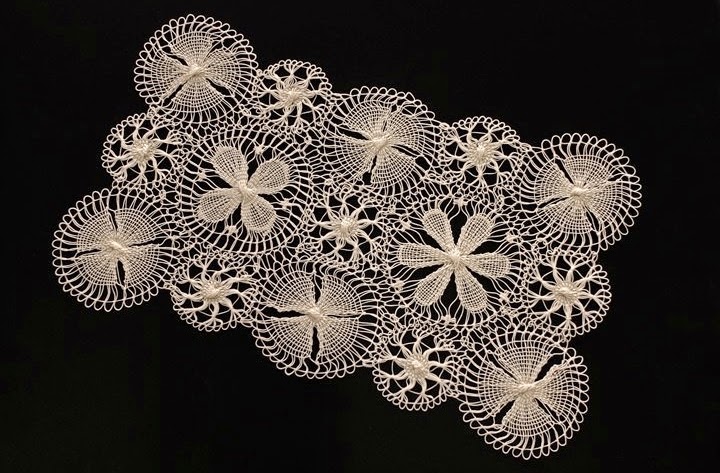
antique Crochet


First Crochet Samples (19/5/2018)
Starting with some first experiments in crochet pattern and different yarn weights and combinations. Possibility to measure different things such as:
– changes in resistance of resistivity yarn
– changes in skin resistance (conductive threads as contact probes)
– capacitive sensing
More Crochet Samples (22/5/2018)
Today we met with Dominique to further discuss the crochet costume and how to feed-back the data to herself and the habitat she will perform in.
The performance she is developing will become a lecture performance about “free time” in which she will share with the audience her research into this subject as well as perform her routine of “Liquidity”. It is for this Liquidity performance that we are creating a crochet costume to capture the physical translation of the liquid state into which Dominique enters.
Notes from meeting
[insert]
5 minutes of Liquidity
Before leaving, Dominique let us watch her perform her daily Liquidity routine/training/ritual (to which she contractually bound herself for the duration of her Phd). This session lasted 5 minutes and gave us a nice idea of what she means when she talks about reacting to the energy in the space. From seeing her move, one idea came up, to add feet to capture movement of the body affecting pressure points under feet.

Gravity
The other main idea that came up through talking was the role of gravity in representing another physical force on her body, on the fabric, on the sensors…. that we could use in constructing the textile sensors / sensor fabric.
In order to have a heavy object embedded in the fabric I started crocheting around a marble but then soon moved on to crochet around a Danish Kroner coin – liquidity of money meets liquidity of resistance (in yarn, in skin) and/or gravity!
Capturing Process…. in the pattern?
We talked about how to capture our own process of creating the costume… because time is another element at play in the ideas around free time.
Even More Crochet Samples (24/5/2018)
Yesterday and today we continued to crochet to explore different material combinations, aesthetics, and sensing techniques. Using coins/currency as weights that pull on the resistive yarn, swaying and making or not making contact to the body seem to be leading the way as they make the connection to the double meaning of liquidity as Dominique means it.
Today Mariam joined us in crocheting and she was much faster, but also more focused than we were. Since we were still thinking about how it will all come together and we gave her the straight-forward task of copying the coin design. She managed to make 3 copies in about 2 hours.
Finishing off the sleeve (20/6/2018)
Deciding tightness of the sleeve:
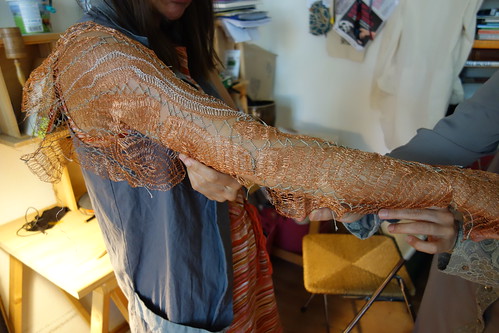
Mariam at work crocheting the enameled wire patches together with gray emrbroidery thread:

Sleeve with coins pinned on to decide placement:

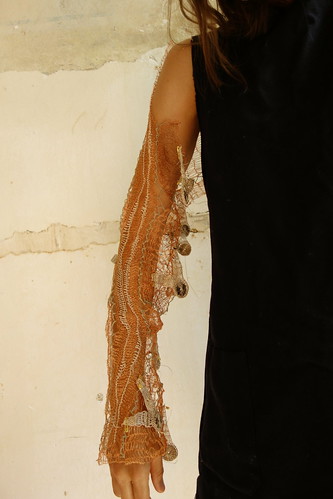
Bringing things together (22/6/2018)
Working outside with good light to finish the circuit connections between the individual coin sensors.
Sketches of different parts that could snap together.
Powermesh tight top to attach crochet to:

Pouch for x-OSC wireless module and battery:

Bionik (28/8/2018)
How to produce crochet that does not like like your grandmother made it and instead looks more…
…scientific
…natural
…bionik
https://www.craftsy.com/crocheting/patterns/irregular-grid-netting/196952

Irish lace:





Blobs, nutrition circuitry and yellow background? (8/10/2018)
After our last meeting with Dominique we’ve decided to move away from the skin-tight bionik costume and into a wearable petri-dish cape.
The whole piece can be roughly divided into:
– headpiece + petri-cape (conductive blobs and nutrient circuitry lines, yellow non-conductive filler/background)
– neck piece with beaded tilt sensors (transparent glass beads)
– hands with crochet wire-ball tilt sensors
For the shape of the crochet balls – maybe something similar in form to the work of:
SOWON JOO: https://www.yooladesign.com/blogs/news/sowon-joo-wire-crochet-art-jewelry

Ruth Asawa: https://www.ruthasawa.com/exhibition/ruth-asawa-permanent-installation/

We currently have most of the metal crochet done for the copper blobs. Now starting work on the nutrition-feed lines that will make up the circuitry between them.
Also starting on using the yellow filler/background thread. The yellow we got from the turkish market it slightly brighter than the golder kind we had one spool of. Not sure if we like this shade of bright yellow…. although it does remind of slime-mold…. but in the design the yellow would be the background/filler and the copper will be the “mold” growing to form the electrical circuit.

Mariam’s speed crocheting
Moments of Doubt (9/10/2018)
The yellow not working and the other colour tests also all mostly not looking as we imagined made us reconsider some older fragments of ideas…. to use a contrasting material such as rubber or latex…. but how to combine with the crochet copper “blobs” that should represent the slime-mold?
To lasercut the latex into some sort of lace-like irregular grid?
To 3D print a flex filament to make a hand-printed crochet like design?
>> https://studiosesperisi.wordpress.com/

Beaded Sway Sensor Development (14/10/2018)
The beads take a while to string, so i didn’t manage to try many variations yet. i agree the transparent with copper core looks good, but the big downside is that the copper thread does not let the beads “dangle” as freely/smoothly as with cotton sewing thread. here some videos to demonstrate.
contact test:
softness of angle:
wear tests:
test next:
– what softer thread could be used inside the transparent beads instead of copper.
– what colour beads and what combination to use – transparent, milky, copper, black?
– what shape to create… symmetrical, or off-center?
– single layer or layered (shorter beads in front of longer)?
– line of beads along the crease of head-to-neck or also beads traveling out towards the chin?
– single tilt sensor or multiple?
Quick Question (29/10/2018)
For the beaded chin movement sensor, which of the following descriptors describe the kind of movement you imagine this sensor would both visually display and physically sense?
droop, drag, hang, sag, swing, sway, suspend, supported from above, wave, trail, stream, depend
pendulous, pendent, swinging, swaying, trailing, flowing, falling, tumbling
quiver, quake
judder, jiggle, jig, joggle, jog, jerk
waggle, wiggle, wriggle, wobble
sway, swing, shake, shiver, shudder, squirm, slant
twitch, totter, teeter, tremble
rock, roll
flutter, flap
vibrate, move, fidget, manipulate, bend, mould
influence, affect, bias, persuade, prevail
oscillate, convulse
lean, tip, list, slope, camber, bank, incline, pitch, dip, cant, bevel, angle, cock, heel, careen
Crochet growing on KOBA Cam (8/11/2018)
For the last months, our main worktable has been occupied with Dominique’s crochet, which Mariam is diligently “growing” by hand.
Mariam at work:
Beaded Sway Sensor Developments (8/11/2018)
Progress has been slow, but getting there….
Here a more technical post of the sensor >> https://www.kobakant.at/DIY/?p=7370
A first look at the graphed values of reading the Beaded Sway Sensor as an analog input:
Sensor Behaviour
From playing with it a bit, it looks like the sensor behaves like this…
When resting the intervals between connections are close:
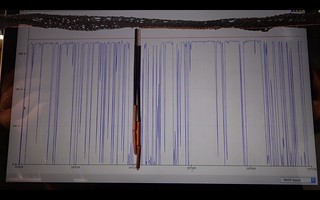
When moving and banging against one another:
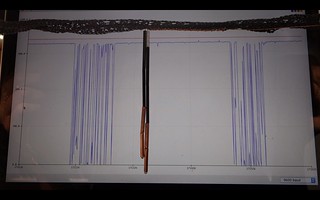
When swaying in unison so that they never/rarely/only occasionally touch:

Then… how should it look? …and how to thread all these dangling bead strands so that if one tears or the thread breaks at one point, the whole thing does not fall to pieces?
How should it look?
Drawing mostly from Dominique’s sketches that hint at a vague shape, behavior, placement. Adding to this the requirements that:
– it should fit in to the overall aesthetic appearance of the organic.
– should integrate with the crochet quality of the “poncho” – – should NOT appear as a separate jewelry item.
– should match the blue and copper material/colours.
– produce sound when moved by glass beads hitting one another.
A quick way to prototype how to string the beads was to simply lay them next to each other:
Here the Sway Sensor embedded into the necklace with more beads:
8-shaped ear-holding design…. I’m not sure how well this will actually work…. but I think we can easily modify it to blend in with the poncho’s hood and alter how it is held in place too.
The Head (8/11/2018)
December 20th: current development

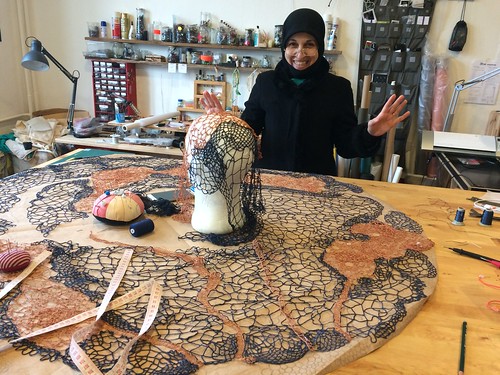
Mariam is almost finishing the cape! it is almost done!







